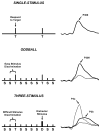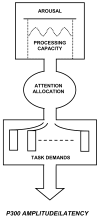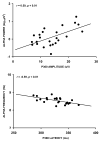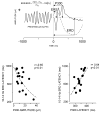Updating P300: an integrative theory of P3a and P3b
- PMID: 17573239
- PMCID: PMC2715154
- DOI: 10.1016/j.clinph.2007.04.019
Updating P300: an integrative theory of P3a and P3b
Abstract
The empirical and theoretical development of the P300 event-related brain potential (ERP) is reviewed by considering factors that contribute to its amplitude, latency, and general characteristics. The neuropsychological origins of the P3a and P3b subcomponents are detailed, and how target/standard discrimination difficulty modulates scalp topography is discussed. The neural loci of P3a and P3b generation are outlined, and a cognitive model is proffered: P3a originates from stimulus-driven frontal attention mechanisms during task processing, whereas P3b originates from temporal-parietal activity associated with attention and appears related to subsequent memory processing. Neurotransmitter actions associating P3a to frontal/dopaminergic and P3b to parietal/norepinephrine pathways are highlighted. Neuroinhibition is suggested as an overarching theoretical mechanism for P300, which is elicited when stimulus detection engages memory operations.
Figures












Comment in
-
P3b: towards some decision about memory.Clin Neurophysiol. 2008 Apr;119(4):968-70. doi: 10.1016/j.clinph.2007.11.175. Epub 2008 Jan 25. Clin Neurophysiol. 2008. PMID: 18222107 No abstract available.
References
-
- Ademoglu A, Demiralp T, Yordanova J, Kolev V, Devrim M. Decomposition of event-related brain potentials into multicomponents using wavelet transform. App Signal Process. 1998;5:142–151.
-
- Ademoglu A, Micheli-Tzanakou E, Istefanopulos Y. Analysis of pattern reversal visual evoked potentials (PRVEP’s) by spline wavelets. IEEE Trans Biomed Eng. 1997;44:881–890. - PubMed
-
- Alexander J, Bauer L, Kuperman S, Morzorati S, O’Connor S, Rohrbaugh J, Porjesz B, Begleiter H, Polich J. Hemispheric differences for P300 amplitude from an auditory oddball task. Int J Psychophysiol. 1996;21:189–196. - PubMed
-
- Alexander J, Polich J. P300 differences between sinistrals and dextrals. Cogn Brain Res. 1995;2:277–282. - PubMed
-
- Alexander J, Polich J. Handedness and P300 from auditory stimuli. Brain Cogn. 1997;35:259–270. - PubMed
Publication types
MeSH terms
Substances
Grants and funding
LinkOut - more resources
Full Text Sources
Other Literature Sources
Miscellaneous

